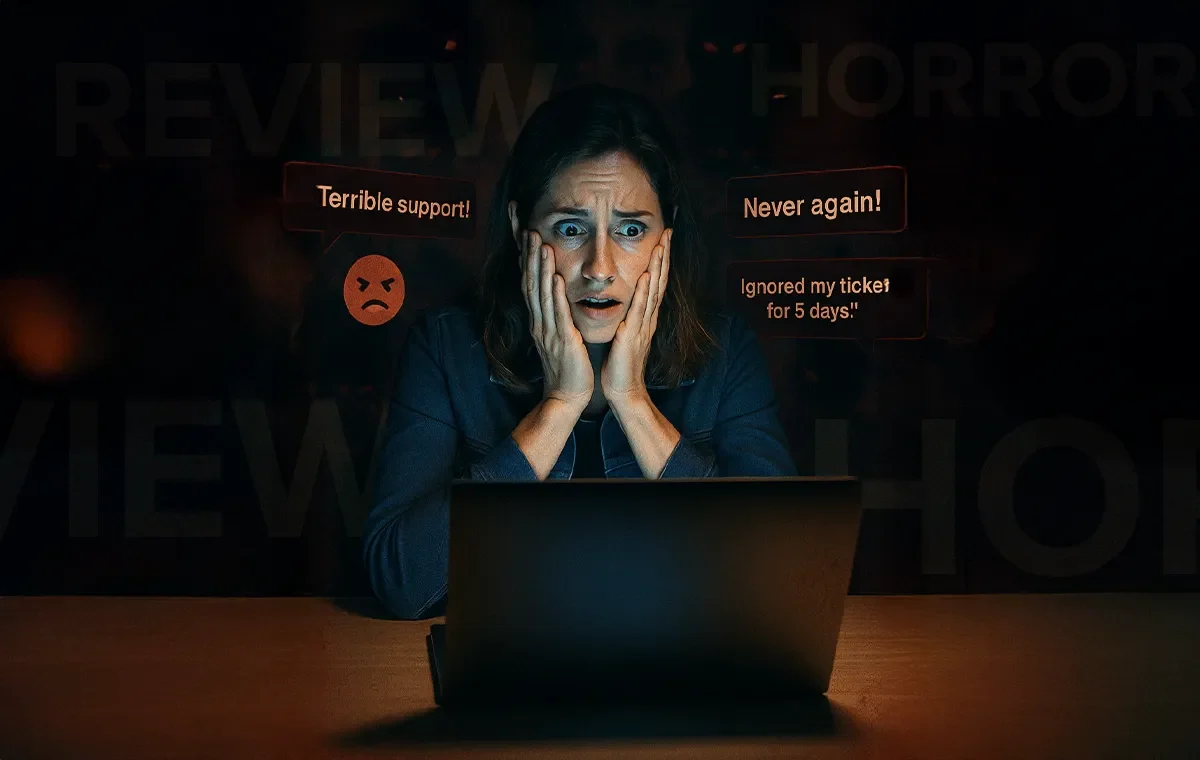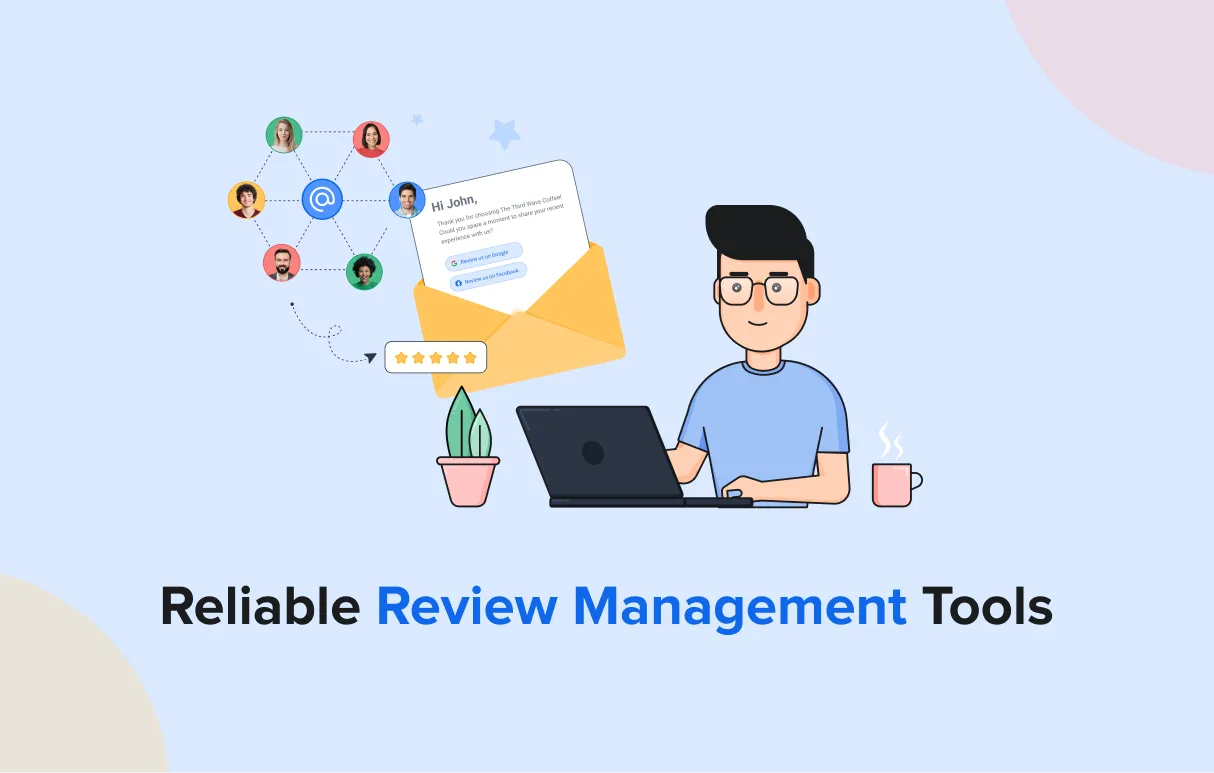Ever found yourself caught in the middle of a review management disaster?
Brands and businesses, big or small alike, have faced it: ignored complaints, tech glitches that ruin your rep, and fake reviews that leave you scrambling for damage control. It’s a nightmare that’s all too real, and it can happen to anyone.
If you are managing local brands, your one small mistake can snowball into a full-blown crisis. But don’t worry, we’ve got you covered.
In this post, we’ll take you through the review management horror stories you don’t want to repeat. We’ll break down what went wrong, why it matters, and, most importantly, how you can avoid the same mistakes and protect your online reputation.
Ready to turn your reputation management from a disaster to a success?
Let’s dive in.
Top Review Management Pitfalls and How to Avoid Them(With Examples)
In today’s digital world, a single reputation management mishap can send your brand spiraling into chaos.
Moving forward, we’ll reveal the most terrifying online reputation management blunders made by top businesses and brands to show you just how quickly things can go horribly wrong—and how to avoid disaster.
1. Ignoring Negative Reviews: A Recipe for Disaster
Ignoring negative reviews? It’s like sweeping a fire under the rug and hoping it doesn’t burn the house down. Pepsi learned this the hard way with their Kendall Jenner ad scandal—here’s how that turned into a full-blown PR disaster.
Case Study: Kendall Jenner’s Pepsi Ad (2017) – A PR Horror Story
Pepsi launched its “Live for Now” campaign with a commercial featuring Kendall Jenner. In the ad, Jenner interrupts a protest to hand a Pepsi to a police officer, supposedly to promote peace and unity. However, the backlash was swift—people accused Pepsi of trivializing serious social issues like police brutality and protests, particularly movements like Black Lives Matter.
Instead of addressing the backlash immediately, Pepsi ignored the mounting criticism. They offered a weak defense of the ad, stating it was intended to promote peace, but this only fueled further outrage.
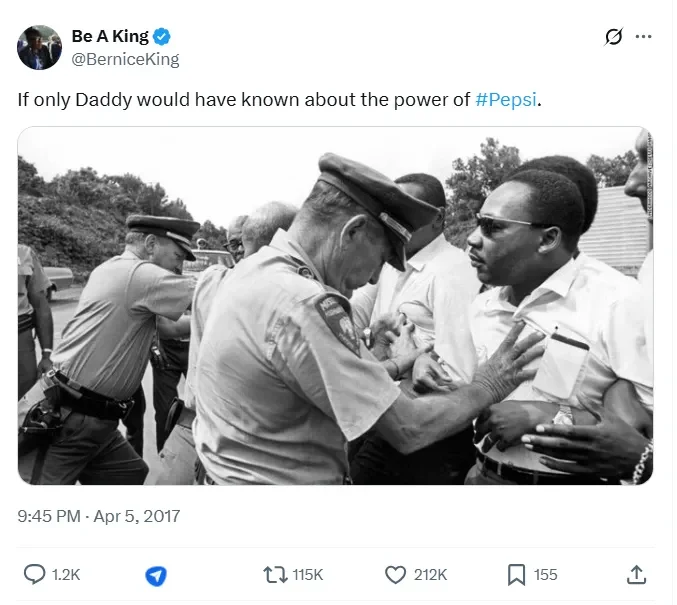
The Disaster Unfolds:
The backlash went viral, and so did memes, mockery, and global outrage. Pepsi’s failure to act quickly made a minor issue explode into a global scandal. This is what happens when you let negative feedback fester.
And then Pepsi published an apology.
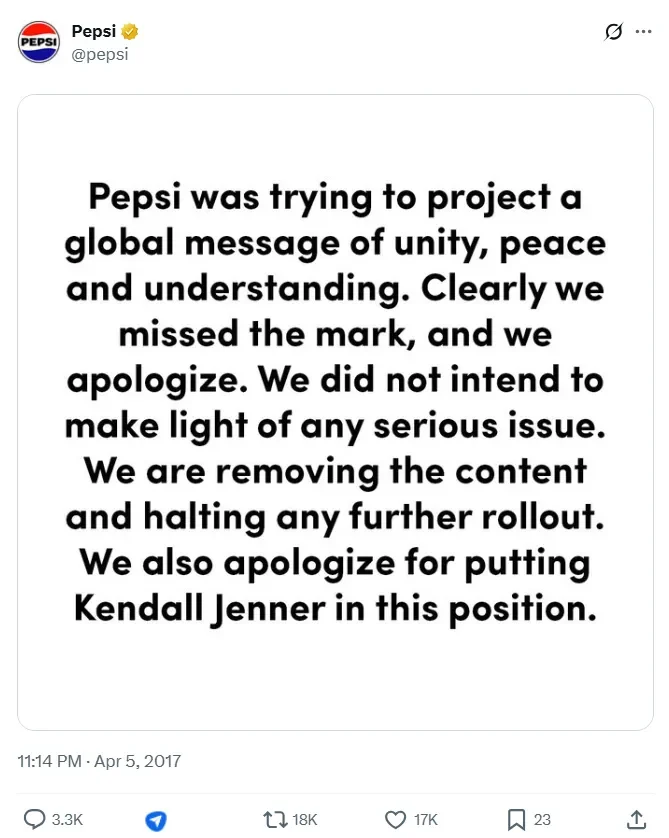
Lost Trust & Millions in Damage
In the aftermath, Pepsi’s brand faced millions of dollars in losses. The failure to address negative feedback in real-time led to a significant blow to the brand’s credibility, and it took months to recover from the backlash.
What Went Wrong:
Ignoring criticism when your brand is under fire only makes the situation worse. Pepsi failed to engage when the backlash hit. Instead of a quick apology, they doubled down, making things worse. Imagine what would’ve happened if they had acted fast.
How They Could Have Fixed It:
- Immediate Engagement: As soon as the backlash began, Pepsi should have addressed the criticism head-on, showing they were listening and taking responsibility.
- Transparent Apology: A genuine, public apology acknowledging the mistake and the cultural insensitivity would have helped to diffuse the situation.
- Proactive Social Listening: Responding to feedback on platforms like Twitter and Facebook could have helped Pepsi steer the conversation in a more positive direction.
Key Takeaways
- Speed is Critical: When negative feedback starts to pour in, act quickly. Delays or silence can make the problem worse.
- Show Empathy: Acknowledge the pain or frustration your customers are feeling, and show that you genuinely care.
- Don’t Deflect: Instead of justifying or defending a bad decision, take responsibility and work toward a solution.
2. Automated Systems Gone Wrong: When Tech Fails
Automated systems are designed to make processes more efficient, but when they malfunction, they can create PR disasters. Oreo learned this the hard way when its automated Twitter reply bot sent out an inappropriate message.
Case Study: Oreo’s Offensive Auto-Reply (2014)
In 2014, Oreo launched a Twitter campaign encouraging fans to tweet about their love for the brand. However, things quickly went off the rails when an automated reply from Oreo’s bot accidentally included an offensive word. The bot was programmed to automatically respond to specific keywords in tweets, but it failed to filter out a derogatory term, leading to a public backlash.
What Went Wrong:
The bot, instead of sending a neutral reply, sent a message that included a racial slur from a Twitter handle. This blunder was caught quickly, but not before it spread like wildfire on social media.
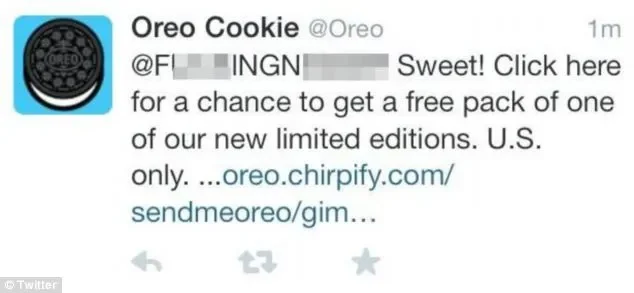
The Disaster Unfolds:
Once the offensive tweet went viral, Oreo’s social media team scrambled to delete the post and issue an apology. But the damage was done. Oreo’s automated system exposed a massive lack of oversight, and the incident turned into a public joke.
Consequences:
- Public Backlash
- Brand Trust Erosion
- Social Media Repercussions
How Oreo Could Have Avoided It:
- Lesson learned: Tech alone wasn’t enough; human oversight should’ve been prioritized.
- Quick action: As soon as the automation malfunctioned, they should’ve acted swiftly, issued an apology, and stopped relying on an automated message.
- Proactive testing: Regularly monitoring and testing automation before it was deployed publicly could have saved Oreo from this blunder.
Key Takeaways:
- Automation Needs Human Touch: Bots are powerful tools, but they can’t replace the nuance of human judgment, especially when sensitive language is involved.
- Test & Monitor: Always test automated systems thoroughly before deploying them, and continue monitoring for any unintended consequences.
- Be Ready to Apologize: If an automation failure occurs, apologize quickly and openly. Acknowledge the mistake and outline how it will be prevented in the future.
3. Responding Poorly to Negative Reviews: Turning a Molehill into a Mountain
One bad review is bad. But a bad response? That’s like throwing gasoline on a fire. Want to see how a Leeds takeaway restaurant turned a small complaint into a viral meltdown? Let’s dive into this nightmare.
Case Study: The Oriental Express Owner Meltdown (Leeds, UK)
In 2021, The Oriental Express, a Chinese takeaway in Leeds, found itself under fire, not because of the food, but because of how the owner responded to bad reviews. What could have been a routine customer service moment quickly turned into a local PR mess.
What Went Wrong:
Instead of addressing negative feedback with professionalism, the owner responded aggressively and insultingly to unhappy customers’ reviews. One user complained about portion size and service, only to be called an “idiot” in a public reply. Others were told to “cook your own food” if they didn’t like it.
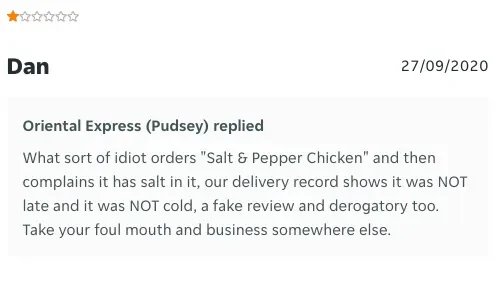
Rather than diffusing the situation, these comments fanned the flames, making customers feel attacked and dismissed.

The Disaster Unfolds:
Screenshots of the owner’s harsh responses started circulating online, drawing more attention to the bad reviews and leading to a flood of 1-star ratings. Locals began avoiding the restaurant not because of the food, but because of the attitude.
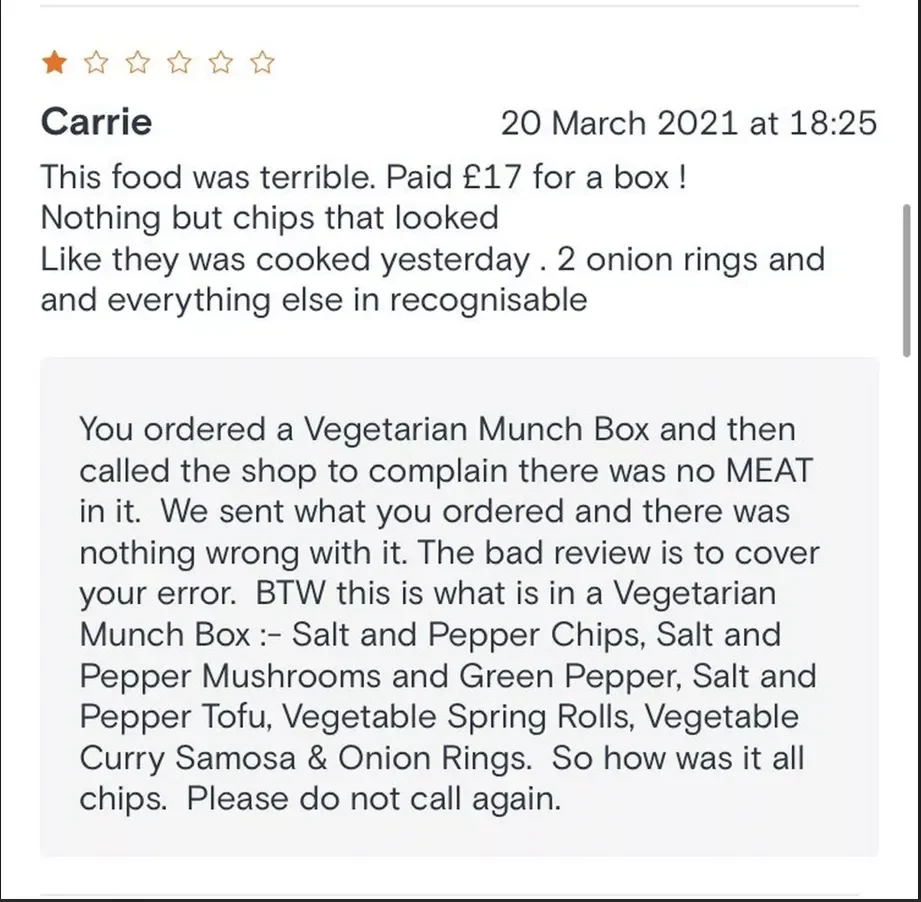
What started as a few unhappy diners ended in public shaming, viral backlash, and a reputation that was no longer about food quality, but about hostility.
Consequences:
- Public Backlash
- Brand Damage
- Loss of Trust
How Oriental Express Could Have Avoided It:
- Lesson learned: Responding with empathy instead of defensiveness could have completely changed the outcome.
- Pro Tip: They could’ve taken the conversation offline and invited the customer to resolve the issue privately, preventing it from spiraling out of control.
Key Takeaways
- The Reply Is Public Too: When you respond online, you’re not just talking to one person—you’re speaking to everyone reading.
- Don’t Take It Personally: Feedback can sting, but reacting emotionally will always backfire.
- Be the Bigger Brand: Professional, helpful responses turn critics into fans. Angry replies turn them into megaphones.
4. Fake Reviews: When the Truth Comes Out
Fake reviews might give you a temporary boost, but once the truth surfaces, it’s a reputation-wrecking ball. Just ask Sunday Riley, whose review manipulation scheme left their brand shattered.
Case Study: Sunday Riley’s Sephora Review Scam (2015–2017)
From 2015 to 2017, employees at Sunday Riley were instructed by the CEO herself to write fake positive reviews for their products on Sephora. This wasn’t just an informal tactic—internal emails surfaced where staff were coached on exactly what to say, how to cover their digital tracks using VPNs, and how to downvote negative reviews so they’d disappear.
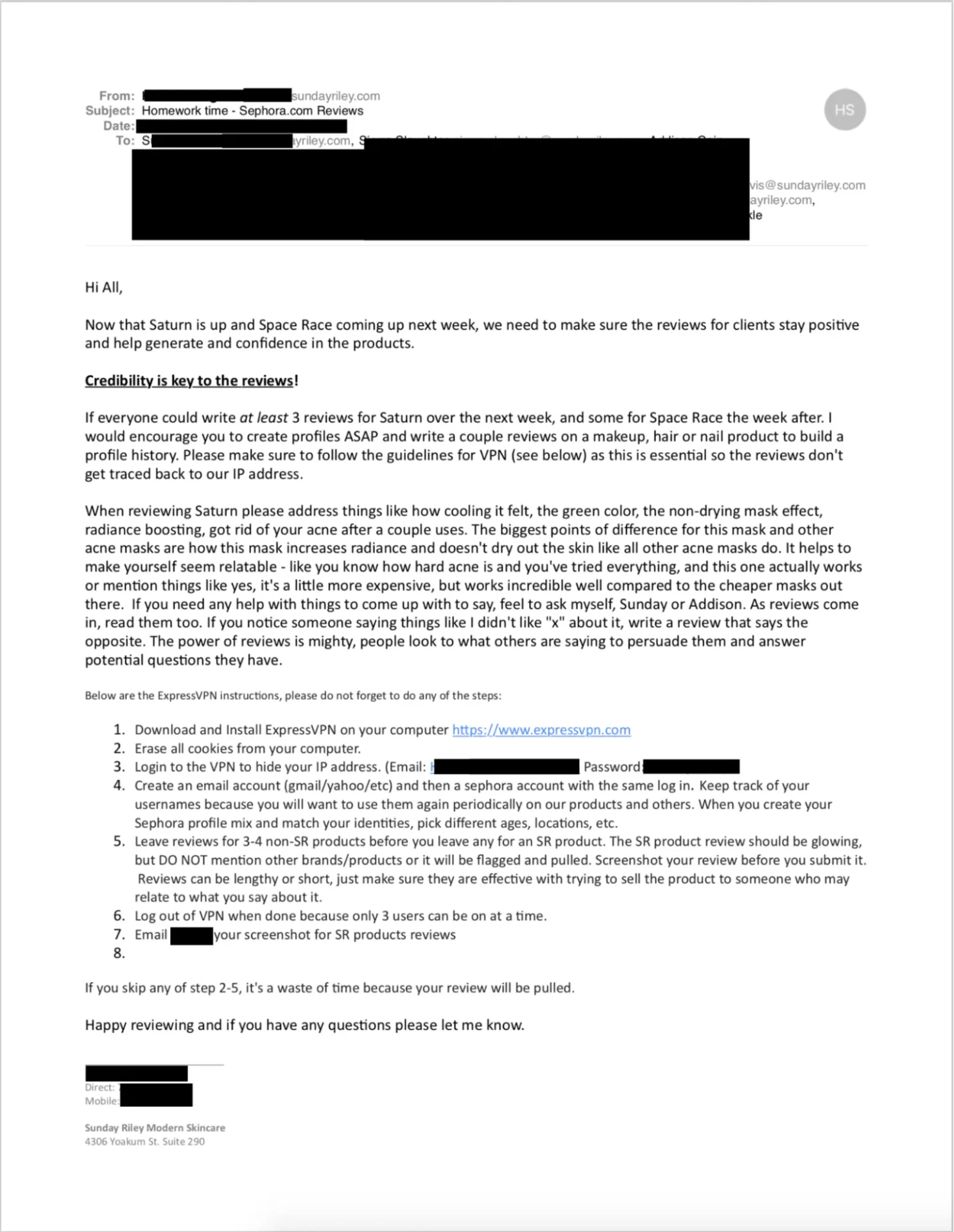
What Went Wrong:
Instead of letting honest customer feedback build their reputation, Sunday Riley tried to manufacture trust. The fake reviews described flawless results and raved about product performance, creating an illusion of overwhelming praise.
But it wasn’t real, and eventually, a whistleblower leaked the internal emails on Reddit, sparking an FTC investigation and a brand reputation nightmare.
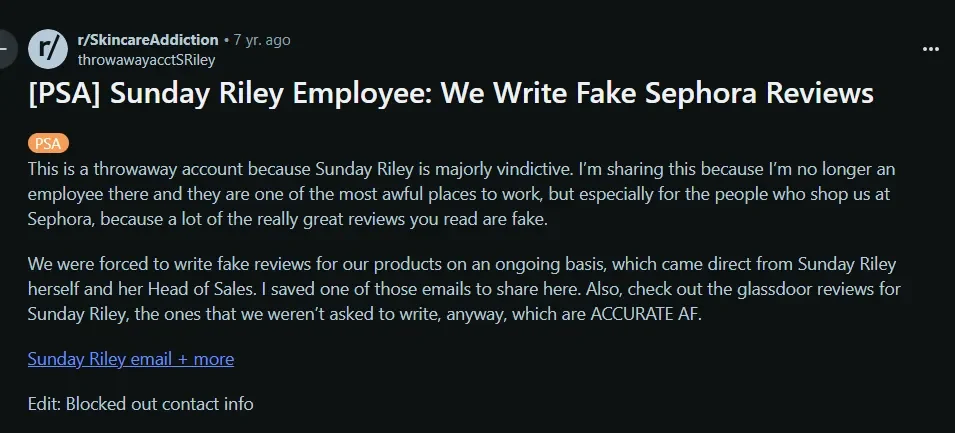
The Disaster Unfolds
The leaked email made it clear this wasn’t a one-off incident. Employees were asked to post from multiple fake accounts, avoid detection by Sephora’s moderation filters, and bury any negative sentiment.
The story was picked up by major media outlets, customers felt deceived, and the brand was forced to settle with the Federal Trade Commission in 2019. The scandal made headlines, tarnishing the “clean beauty” brand image Sunday Riley had worked so hard to build.
Consequences
- FTC Investigation: The FTC charged Sunday Riley for misleading consumers by using deceptive review practices.
- Media Backlash: Coverage from Vox, The Verge, and Reddit went viral, spreading the scandal far and wide.
- Lost Trust: Customers who once swore by the products now questioned everything—was it the skincare or just smoke and mirrors?
How Sunday Riley Could Have Avoided It:
- Lesson learned: Don’t fake it till you make it—authenticity in building trust is key, and fake reviews only work short term.
- Long-term solution: They should have practiced transparent and ethical review practices, incentivizing feedback the right way, and always being upfront about their process.
- Your reputation is earned. Learn how to respond to bad reviews with honesty and show how they were using customer feedback to improve, which would have gone a long way in protecting their reputation.
Key Takeaways:
- Fake Trust is Fragile: It only takes one exposure to crumble a reputation built on deception.
- Customers Aren’t Stupid: People can spot overly polished, repetitive reviews—and they talk.
- Transparency Wins: In the long run, integrity in how you collect reviews is worth far more than inflated star ratings.
5. Ignoring Customer Feedback: How Not Listening Can Cost You
When you ignore your customers, you risk more than just their frustration—you risk losing them entirely. Just ask Netflix about their Qwikster debacle.
Case Study: Netflix’s Qwikster Fiasco (2011)
Ignoring your customers’ feedback isn’t just risky—it can cost you millions. Netflix learned this the hard way in 2011 when it launched Qwikster, a service aimed at splitting its DVD rental and streaming services into two separate brands. The backlash was immediate and devastating.
What Went Wrong:
Netflix ignored the growing dissatisfaction among its customers when it announced the price hike and the separation of services. Instead of listening to their audience, Netflix moved ahead with Qwikster, thinking it would streamline their operations. Unfortunately, they were dead wrong.
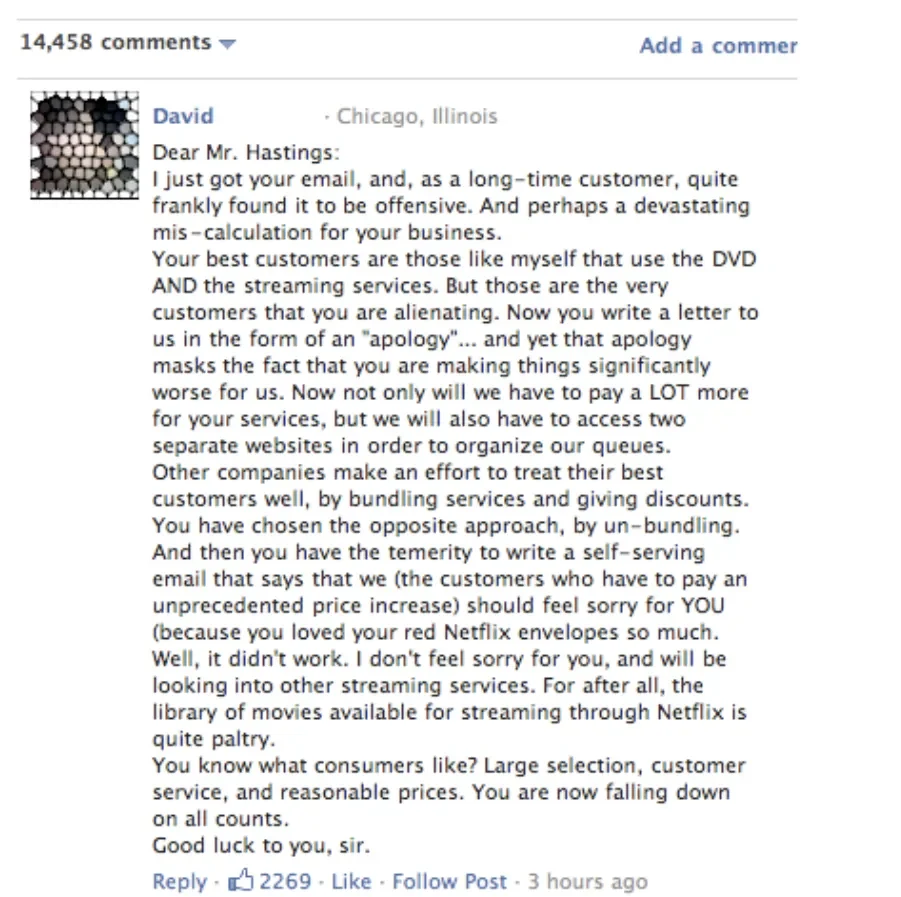
The Disaster Unfolds:
Social media exploded with complaints, and Netflix lost 800,000 subscribers within months. The stock plummeted by 77%, and the company was forced to apologize and scrap Qwikster altogether. Netflix didn’t just lose customers—they lost billions.
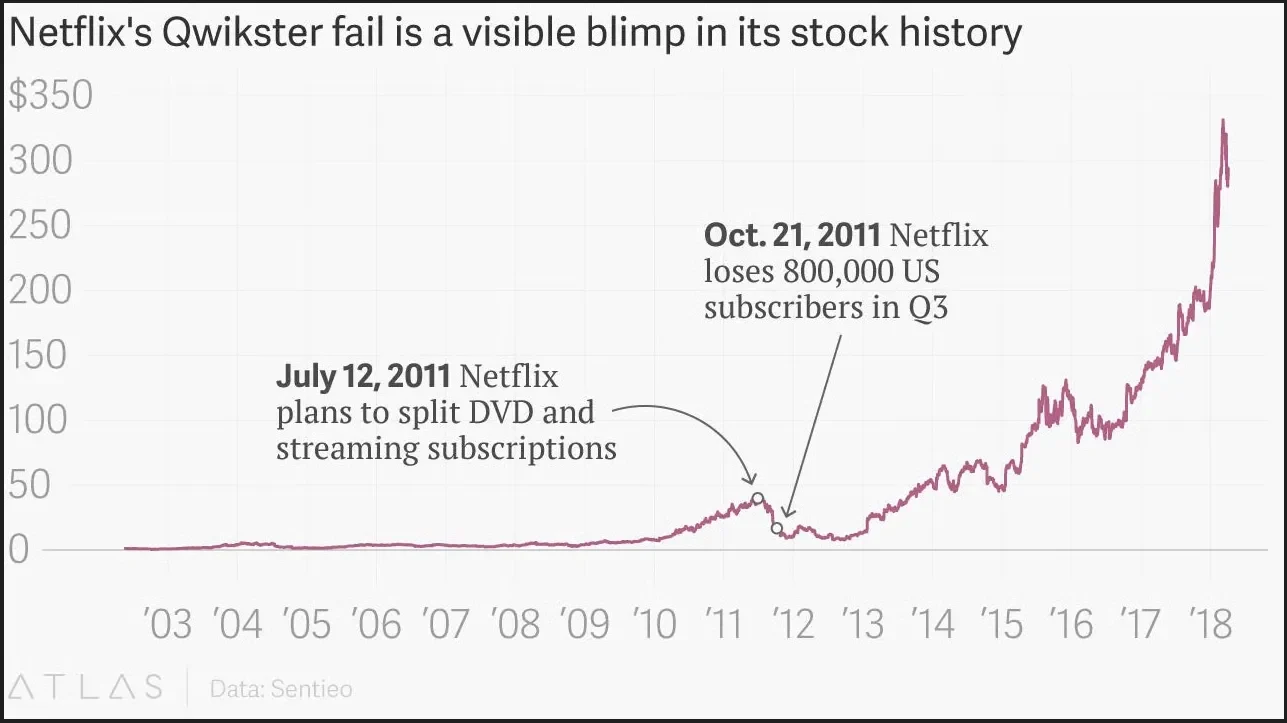
Reed Hastings’ Apology:
In the aftermath of the Qwikster failure, Netflix CEO Reed Hastings acknowledged the mistake in a blog post, admitting,
I messed up. I owe everyone an explanation.
It is clear from the feedback over the past two months that many members felt we lacked respect and humility in the way we announced the separation of DVD and streaming, and the price changes. That was certainly not our intent, and I offer my sincere apology.
His apology reflected Netflix’s failure to listen to its customers and the damage caused by ignoring their feedback.
Consequences:
- Massive Subscriber Losses
- Stock Decline
- Public Backlash
How Netflix Could Have Avoided It:
- Lesson learned: Customer feedback should have been their compass—listening to concerns before making changes could have avoided the backlash.
- Test, don’t guess: Instead of making sweeping changes, they could have surveyed their audience to ensure they were on the right track.
- Act quickly: Acknowledging feedback right away, rather than waiting until it was too late, would have helped them navigate the situation more smoothly.
Key Takeaways:
- Customer Feedback is Gold: Netflix’s failure to listen led to one of the biggest mistakes in its history.
- Don’t Get Overconfident: Even industry giants like Netflix can falter if they ignore their customers.
- Communicate Changes Clearly: Sudden, uncommunicated changes make customers feel alienated and lead to chaos.
6. Failing to Engage with Positive Reviews: Missing a Golden Opportunity
Failing to engage with positive reviews is a missed opportunity to build loyalty and amplify good word-of-mouth. While brands often focus on resolving negative reviews, ignoring the positive ones can hurt long-term customer relationships. This is exactly what happened to a local café, and it serves as a cautionary tale.
Case Study: The Silent Treatment to Happy Fans
In a 2020 survey, 40% of customers expected a simple “thank you” after leaving a positive review, but many businesses still fail to acknowledge this free form of marketing.
According to Harvard Business Review, companies with strong customer loyalty grow their revenue 2.5 times faster than their competitors.
What Can Go Wrong:
Instead of capitalizing on the good reviews, you can miss the opportunity to engage with customers who were already promoting the brand voluntarily. These happy customers had just provided free publicity—yet, you are not acknowledging it.
The Disaster Unfolds:
While you may be too busy or didn’t need to respond to positive feedback, the lack of engagement resulted in a growing perception that you simply didn’t care about your regulars. Some loyal patrons mentioned their disappointment on social media, noting how your brand never showed gratitude for positive reviews.
Consequences:
- Customer Disengagement: Loyal customers who leave positive reviews feel undervalued, leading to a potential loss of repeat business.
- Missed Word-of-Mouth: Positive reviews can be powerful tools for word-of-mouth marketing. When not acknowledged, this tool goes untapped.
- Public Perception: Ignoring positive feedback can create the perception that the brand doesn’t care, which can deter new customers.
How to Fix It:
- Engagement is key: They should have responded to positive reviews promptly, building stronger relationships with their customers.
- Show you care: A simple “thank you” could have gone a long way in nurturing their most loyal customers.
- Leverage positive reviews: By sharing golden testimonials on social media, they could have amplified their brand and strengthened their reputation.
Key Takeaways
- Engagement is Essential: Don’t let glowing reviews fade into the background. Acknowledge them to build stronger customer relationships.
- It’s Free Marketing: Positive reviews are valuable marketing assets. Use them to your advantage by engaging and thanking your customers.
- Show You Care: Every review is a chance to show appreciation, build loyalty, and continue to grow your brand’s reputation.
7. The Danger of Over-Editing Reviews: The Fine Line Between Polishing and Manipulating
Over-editing reviews might seem like a good idea, but it’s a dangerous game that can destroy your credibility. Just ask Fashion Nova, whose attempt to hide negative reviews exposed them to a huge public backlash and legal repercussions.
Case Study: Fashion Nova’s Hidden 1-Stars (2022)
Fashion Nova, a popular fashion retailer, found itself in hot water when it was discovered that it had been suppressing negative reviews to maintain a glowing reputation on its website. They intentionally hid below 4-star reviews from consumers to make their products look better than they really were.
What Went Wrong:
Fashion Nova’s review system had a filtering issue: a complaint was filed saying that they were blocking hundreds of thousands of negative reviews, particularly those under 4 stars. This artificially inflated product ratings and misled shoppers into thinking they were purchasing items with perfect feedback.

The Disaster Unfolds:
When the Federal Trade Commission (FTC) investigated, it was revealed that the company’s actions were deceptive. Fashion Nova was forced to settle with the FTC and pay $4.2 million for its actions. In addition to the financial penalty, the company’s reputation took a significant hit.
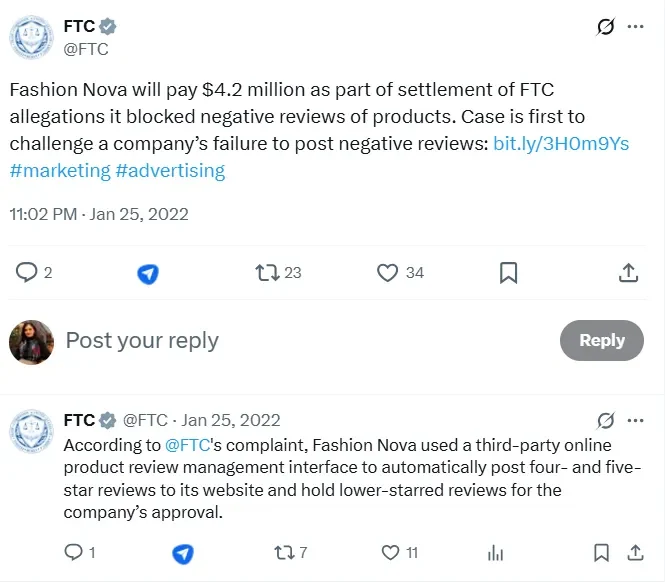
Consequences:
- Reputational Damage: Trust in the brand eroded as consumers realized they had been misled.
- Legal Repercussions: A hefty fine from the FTC, along with a public statement on deceptive practices.
- Loss of Credibility: Fashion Nova’s reputation for authenticity was forever tarnished.
How Fashion Nova Could Have Avoided It:
- Honesty is the best policy: They should have avoided manipulating feedback and allowed it to speak for itself.
- Transparency wins: Instead of hiding negative reviews, embracing them and addressing the feedback head-on would have shown their commitment to improvement.
- Avoid filtering: Reviews should only be removed if they violate platform guidelines (e.g., hate speech, spam). Maintaining authenticity was crucial.
Key Takeaways:
- Fake Trust is Fragile. Once customers realize they’ve been deceived, it’s hard to rebuild trust.
- Consumers Aren’t Stupid. Fake reviews are easy to spot—and when they are exposed, the damage is irreversible.
- Legal Risks. Review manipulation isn’t just unethical—it’s illegal. Don’t risk your brand’s integrity.
8. Relying Solely on One Review Platform: Putting All Your Eggs in One Basket
Relying on just one review platform is like putting all your faith in a single tightrope. If that platform changes, your business could plummet. Just ask the countless businesses that were left scrambling after Yelp’s 2018 algorithm change.
Case Study: Yelp Algorithm Apocalypse (2018)
In November 2018, Yelp’s algorithm underwent a significant overhaul. The update aimed to improve the platform’s ability to detect fake and suspicious reviews, but it inadvertently wiped out a huge chunk of legitimate, positive customer feedback.
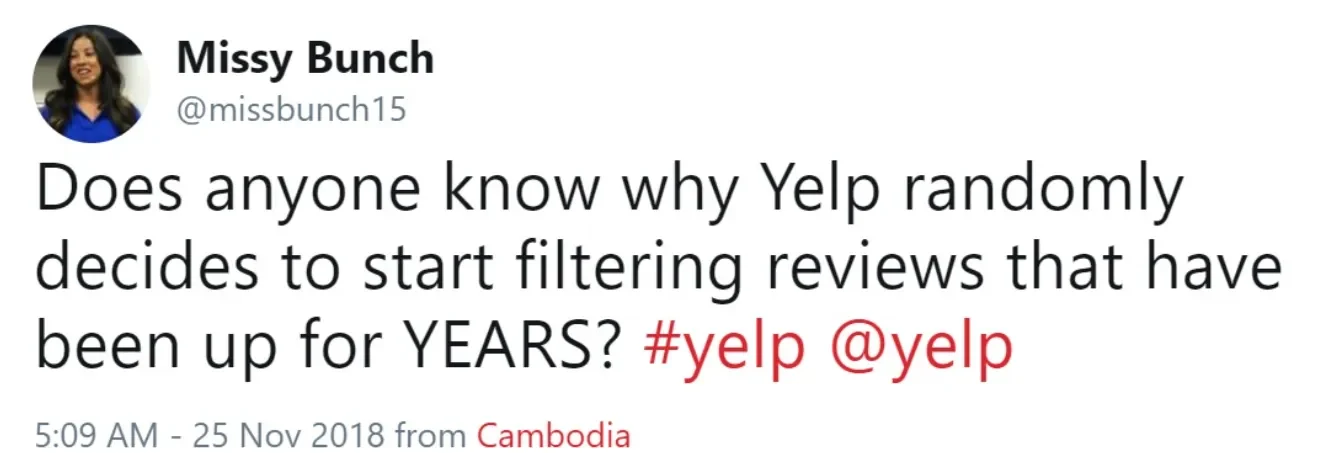

What Went Wrong:
Yelp’s review filtering system, which determines which reviews are displayed on a business’s profile, started hiding positive reviews that previously appeared on the page. Many businesses experienced drastic drops in their ratings, even though they had been receiving positive feedback. For instance, one business saw 97% of its 5-star reviews disappear overnight, while their competitors’ negative reviews remained visible.
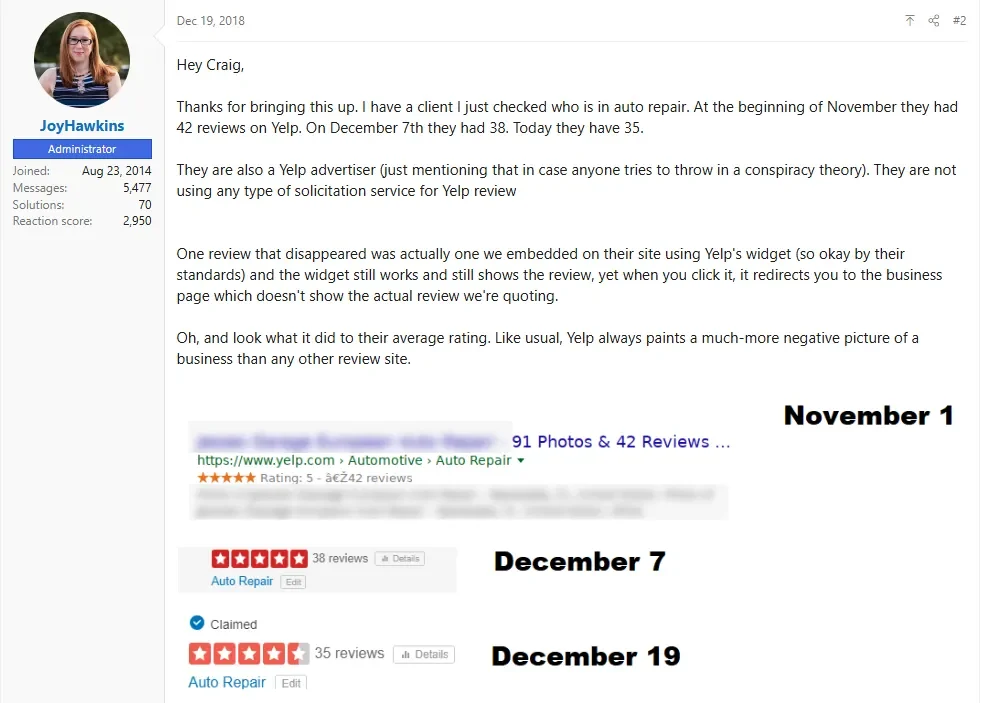
The Disaster Unfolds:
The algorithmic purge created a massive problem: potential customers who searched for these businesses on Yelp saw only negative reviews. Even though the businesses had higher ratings elsewhere, the lack of positive feedback on Yelp severely hurt their credibility. Yelp’s automated system filtered reviews in ways that left these businesses at the mercy of one platform’s decision.
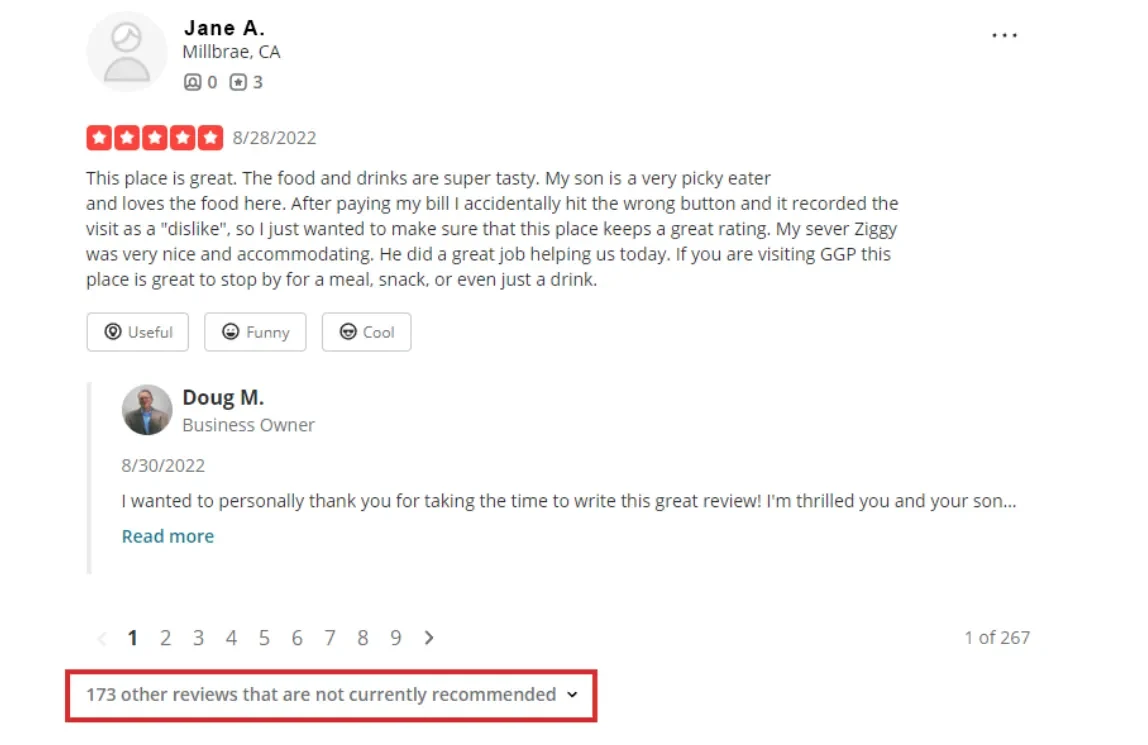
Consequences
- Public backlash: Business owners felt the heat as their Yelp ratings plummeted, often leaving their businesses with a reputation that didn’t match the reality of customer sentiment.
- Loss of Trust: Yelp’s algorithm change not only hurt businesses’ ability to attract customers on their platform but also damaged the trust customers had in the Yelp review system as a whole.
- Lost Revenue: Some business owners reported that the disappearance of reviews led to a sharp drop in customer inquiries and bookings.
How Yelp Could Have Fixed It:
So, how could businesses have avoided this disaster?
- Diversify your review platforms: Yelp should have encouraged customers to leave reviews on platforms like Google, Facebook, TripAdvisor, or Trustpilot, instead of relying solely on Yelp.
- Monitor your reviews: Regularly tracking reviews across multiple platforms could have helped catch negative feedback early and addressed any platform-specific issues, like algorithm changes.
- Respond to reviews: Engaging with all reviews, both positive and negative, would have shown customers that their opinions mattered, helping to build trust and credibility across different platforms.
Key Takeaways
- Don’t Put All Your Eggs in One Basket: Relying too heavily on one review platform makes your business vulnerable to any changes or issues that platform may experience.
- Diversify Your Reputation: Ensure your business has a strong presence across multiple review sites to maintain consistent, positive feedback.
- Act Fast: Stay alert to any changes on your key review platforms, and be ready to act quickly if reviews are suddenly hidden or altered.
In a world where reviews can make or break a business, managing your online presence is crucial. Whether it’s generating positive reviews, addressing negative feedback, or building long-lasting customer trust, SocialPilot’s Review Management Tool makes it easy to streamline and automate your review process.
With SocialPilot, you can effortlessly manage reviews from multiple platforms, ensuring that your brand always looks its best online. The tool also allows you to generate new reviews and market your brand’s reputation to maximize visibility and trust.
Key Features:
- Multi-Platform Management: Handle reviews from Google, Facebook, Trustpilot, and more.
- Automated Review Generation: Get more reviews with automatic prompts after purchases or interactions.
- Real-Time Monitoring: Stay on top of customer feedback and engage instantly.
- Review Marketing: Showcase positive reviews to build brand trust.
- Sentiment Analysis: Understand customer feelings to improve your responses.
Ready to manage your reputation like a pro? Start with SocialPilot today.
Don’t Let Your Brand Become the Next Horror Story
The stakes are higher than ever in the digital age. A single mistake—whether it’s ignoring negative reviews, using bad automation, or failing to engage with positive feedback—can destroy your brand overnight. But by learning from these real-world disasters, you can take action before things go wrong.
The Bottom Line?
Your brand’s reputation is everything. Don’t wait until it’s too late. Start listening, responding, and engaging—or risk becoming the next cautionary tale.
